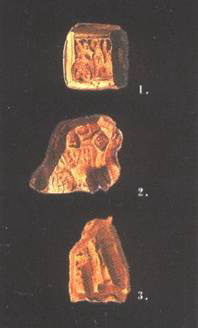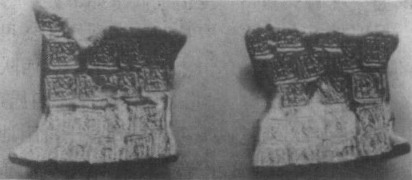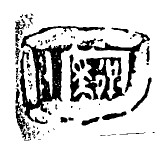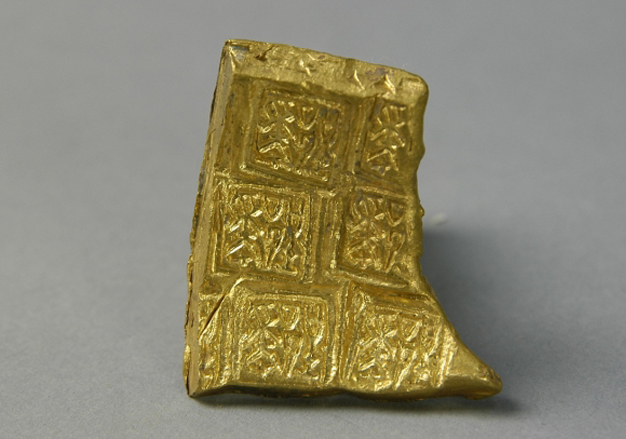
Zhang Ling, teacher of School of History and Culture, Henan University, with a Ph.d degree in the ancient hisotory of China.
“Ying Yuan” gold currency("Ying" being the name of the Chu capital), was dug out by the villagers of the Gucheng village, Fugou county, Zhoukou prefecture, Henan province, simultaneously, other gold currency such as “Ying Yuan”, “Chen Yuan”, Golden horse’s hoof, a great deal of gold cakes, and fragments, were also discovered in a bronze Ding vessel. After acquiring them, the local Cultural House present them to Henan Museum in November of the year.
The artifact, with a shape of tablet, and cutting traces on the edges, features a slightly concave obverse, four negative legend seal impressions from a square seal incised with two characters “Ying Yuan” (郢爰).
“Ying Yuan” gold currency, as a kind of gold coin of the Chu State during the Warring State period, and the earliest gold currency in China, is the important physical reference for studying the ancient currency history of China, and the development of commodity economy during the Spring and Autumn, and the Warring States period.
“Ying Yuan” gold currency, also known as “Stamped Gold”, “Gold Tablet”, “Tablet Gold”, was one of the primary currencies of the Chu State, and mostly square in shape. The stamping method is pressing a couple of seal marks of two characters “Ying Yuan” in the form of seal script on the gold tablet. Except for the two characters “Ying Yuan”, other seal words are also found, such as “Chen Yuan”, “Lu Jin”, etc; the gold percentage is usually over 90. All of these gold currencies shared a formalized shape, inscription, weight, belonging to a metage currency system.
All of the 392 pieces of gold currency excavated at Gucheng village, Fugou county, Henan province in 1974 weigh 8183.3g in total. The 18 pieces of complete gold tablets of Yuan Jin and a small gold block, unearthed at Huayuan village, Shouxian county, Anhui province in 1979, weigh 5187.25g. In 1971, a Ying Yuan, weighs 17.5g, was excavated at Yingcheng, Jingling, Hubei province. All these gold currency of the Chu State vary with gold content, generally between 94~98%, few of them is only around 85%.
The shapes of Chu State gold currency have two types: one is the abovementioned “Ying Yuan” in the form of square or rectangular gold tablet, the other is flat gold disc, and the former is more frequently seen. A great majority of the Chu State gold currencies, are from the archaeological hoards, except for few of them are excavated from tombs or ruins. The historical documents indicate that the gold currency of the time circulated predominantly in the upper classes of the society, mainly used for the purpose of international payment, lobbying the feudal lords of the principalities, gift-presenting from the monarchs, block trade, and so on, which often consumed hundreds, thousands of catties of gold(one cattie weighed about 120 grams) each time, at least one Yi(equivalent to 20 or 24 liang(tael) ). The archaeological findings attest that the Chu gold currency had circulated in the vast regions: the territory under the jurisdictions of Chu State, and the neighboring countries which associated with Chu State economically and militarily, all of these places have yielded Chu State gold currencies.
The territory under the jurisdictions of Chu State was recorded in the ancient texts as the producing place of gold in ancient China, with huge gold reserves and massive gold output which were incomparable for other fiefdoms. Due to the gradual progress of productivity of the time, frequent commodity exchanges, and extension of currency circulation ranges, people came to realize the preciousness of the gold, therefore, the gold coins of Chu State turned up in the Chinese currency history, which was in accordance with the currency’s law of development.
The “Ying Yuan” gold currency excavated at Guanting township, Changge county, Henan in Mar.2000 (Fig.1)

(Fig.1)“Ying Yuan” gold currency excavated at Guanting township, Changge county, Henan in Mar.2000
No.1: it is roughly square in shape, with a intact seal impression of “Ying Yuan”, its longest side is 1.85cm, the short side 1.78cm, thickness:0.44 cm, weight: 15g. The lower edge is smooth, other edges have chopping marks.
No.2: it is irregular trapezoid, with a full “Ying Yuan” seal impression. The longest edge is 2.95 cm, the shortest 1.89cm, 0.46 cm thick, weighs 19g, the whole edges are visibly chopped.
No.3: irregular in shape, with serious scratches on surface, the lower frame of the seal impression “Ying Yuan” can be dimly seen. The longest edge is 2.32cm, the shortest edge 1.81cm, thickness 0.52cm, weighs 15.8g. Cutting marks can be seen on the surface and edges.
The reverse sides of the three gold currencies are universally plain and flat. View from the outside and luster, the trio bear similarity, should be contemporary, are gold currencies of the Chu State of the Warring States period.
The “Ying Yuan” gold currency unearthed at Zhouzhai village, Dongjin township, Shouxian county, Anhui province in Feb.1986 (Fig.2). Most of their left edges are straight and flat, seem to be the cutting marks. The numbers of the seal impressions of “Ying Yuan” characters on each piece are different with each other, largely range 15 to 24; and the seal impressions confront with each other in two arrays on the left, two or three arrays on the right, and the arrays of legend seal impressions on the left are comparatively neater and denser. Among the specimens excavated, 13 have carving traces on the edge or the reverse sides. Measurements: L. 5.5—8.8cm, W. 4.4—8cm, THK. 0.2—0.6cm, W. 253—272g.

(Fig.2)“Ying Yuan” gold currency unearthed at Zhouzhai village, Dongjin township, Shouxian county, Anhui province
In Mar.1971, a “Ying Yuan” gold currency of Chu State was unearthed inside the south city wall of Yingcheng, southeast to the Jinan City of the previous Chu State capital, Chugudu, Jiangling county, Hubei province(Fig.3). On the gold currency, half impression remained which reads: Ying Yuan, weighing 17.53g, with 97.5% of gold.

(Fig.3) “Ying Yuan” gold currency of Chu State unearthed inside the south city wall of Yingcheng, southeast to the Jinan City of the previous Chu State capital, Chugudu, Jiangling county, Hubei province
In 1977, another “Ying Yuan” was found at the ruin of the imperial city of Chu State, Yicheng, Hubei province, the remnant of the gold currency weighs 7.45g, the inscription on the surface was damaged by chopping. Based on the appearance, it was recognized as “Ying Yuan”.
In one word, based on the available archaeological findings, “Ying Yuan” gold currencies have ever been unearthed in several provinces as Henan, Hubei, Anhui, and so on. These discoveries shed light on the circulation radius of this currency of the time, attesting that territorial scope of transactions for the Chu State was extraordinarily far-reaching. The “Ying Yuan” gold currencies discovered in various locations are roughly identical in percentage of gold content, shape, and usage, and show that a unified rule for the gold currency in Chu State had existed, symbolizing the prosperity of commerce in Chu State. “Ying Yuan” originated in the mid-Spring and Antumn period, came into being in the late Spring and Autumn, and gradually died out in the mid-Western Han, had been in circulation for around 4 hundred years, it was the most influential gold coins in the currency history of China.
As the precious metal and cutting-and-weighing currency, the “Ying Yuan” gold coins was valued highly. Then in transactions, how to get the requested weight precisely?
Your answer please, if you have any questions or answer, please feel free to send us email, we are waiting for your answers and participation, and your comments, answers and suggestions will be highly appreciated. We will select and publicize the most appropriate answers and comments some time in the future.
Weekly Selection Email: meizhouyipin@chnmus.net
Commonness and Difference of Currencies Between the Chu and other States in Yellow River Valley
By exploration from the four aspects of medium, shape, inscription, and value, we could find the difference and relationship between the monetary cultures of Chu State and the States in the Yellow River Valley[1].
1. Commonness overtakes difference, both constitute the Chinese monetary culture
In term of medium, gold, copper, tin, lead alloy(bronze) were used for minting currencies not only by Chu State, but also the States in the Yellow River valley.
Regarding the shapes, the monetary culture of Chu State features inheritance of that of Zhou dynasty, being distinctive from the States in the Yellow River Valley that minted their coins in the shape of implements such as knife, Bo(farm tools like hoe, spade), spinning wheel(or jade disc), and so on.
As for the inscriptions, all of the currency characters on the coins derived from the writing script on the bronzes of previous times, not only for Chu State, but also for the States in the Yellow River valley.
For the composition of the currency value, the value structure of the currencies of all the States, i.e. Chu and other States in the Yellow River valley, contained gold and bronze.
2. Two distinctive systems:
As for the material, Chu currency features a high-valued structure, with rich colors, high percentage of precious metals; the currencies of the States in the Yellow River valley had less varieties, with high percentage of the base metals.
In terms of shapes and structures, Chua State currencies had more types, while the States in the Yellow River valley had less.
Regarding the inscriptions, the characters on the currencies of Chu State were smoothly inscribed; for the States in the Yellow River valley, the currencies were cut neatly in relief, both were distinctive on styles.
As for the structures of the value unit, the currency of Chu State saw a special trapezoid structural system of value unit, which the States in the Yellow River valley didn’t have.
3. Influenced each other mutually, and tended to blending
The distinctions of the monetary cultures between Chu State and other States in the Yellow River valley are reflections of their different historical traditions, economic conditions, geographic environments, folk customs. The two monetary cultures influenced, penetrate each other mutually, with a tendency toward mixture.
Bibliography:
1. Zhao Dexin, On the two monetary structures prior to Qin dynasty---an exploration on the difference and similarities between Chu State and the States in the Yellow River valley from the perspective of monetary culture. Jianghan Tribune. Sept.2004
2. The Thirteen Classics with Annotations and Commentary. Photocopy edition, 1980 Zhonghua Book Bureau press. P.882

Title: “Ying Yuan” gold currency
Period: the Warring State period
Measurements: horizontal 3.8cm, vertical: 4.2cm, weight:74g.
Provenance: unearthed at Gucheng village, Fugou county, Zhoukou prefecture, Henan province in 1974.
Owner: housed by Henan Museum